Thank you for visiting! By the way… any links on this page that lead to products on Amazon and other stores/partners are affiliate links Aquarium Store Depot earns a commission if you make a purchase.
First, I would like to say thank you for reading this post. This is going to be a long point about the 55 words of wisdom I wish I knew before I started a saltwater reef tank. This is a list I have been thinking about for some time. Each one of these things can be a post on its own but I feel placing these all on a single post is a great reference to anyone starting out the hobby or wants reminders on general advice on reefing.
So without further ado here is the list on a nice infographic:
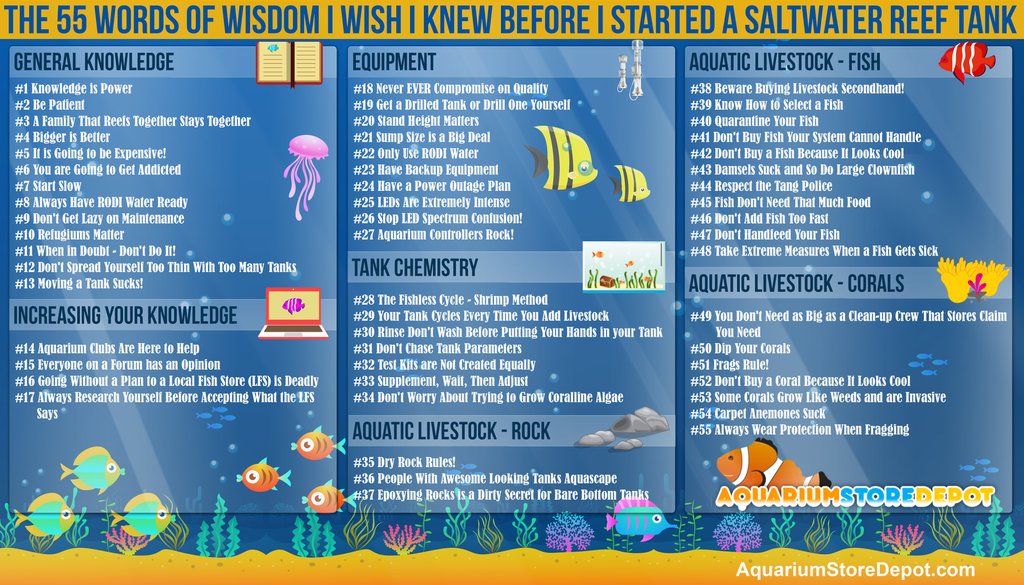
Saltwater Reef Tank – 55 Words of Wisdom I Wish I Knew Before I Started
So now that you have seen the list, here is the detailed breakdown of every word of wisdom below:
#1 Knowledge Is Power

Knowledge plays a huge role in this hobby. What you know will dictate how you will grow your tank and how you grow in the hobby. Taking the time to read books, visit blogs like this one, and getting to know other hobbyists empowers you as a consumer and aquarium owner. If there is anything you takeaway from this blog entry, it is that knowledge is king in this hobby. It will save you time, headache, money, and increase your passion.
#2 Be Patient
This is a very hard lesson to learn even for advanced hobbyist. For a new aquarium keeper, it is very easy to get excited about building your saltwater reef tank and make changes very quickly. As an advanced hobbyist, sometimes we are attracted to deals we see locally or on-line. Other times we try to push the limits of tried and true knowledge.
At the end of the day we need to keep in mind that we are maintaining a delicate ecosystem in our aquariums. Every time we add something or make changes the system needs time to adjust. This is another lesson that sometimes we as hobbyists learn the hard way.
#3 A Family That Reefs Together Stays Together
If you have a family or a significant other, I highly encourage you to get them involved in your saltwater reef tank. Our hobby tends to be a very isolated one where one person does everything and your significant other is wondering why you are spending so much time on your tank, not talking and spending time with them, and why everything is so expensive.
Get them involved! Teach them everything you know and explain the inner workings of the aquarium and habitat. In the end, you will have a significant other that at a minimum will understand how to care for your tank or at least tolerates your passion. You may get lucky and convert your spouse to a full-fledged reef fanatic.
If you have children, this is a wonderful opportunity to teach your children all sorts of great life skills – trade skills from DIY projects, chemistry and biology lessons, responsibility, and discipline. Working with children when it comes to aquariums is a big passion of mine. I actually wrote up an article on FamilyShare.com detailing out various activities you can participate with a child.
#4 The Bigger the Better

Bigger is better in this hobby. A bigger tank = more volume and more stability. A bigger sump = more flexible space, more volume, and more stability. A bigger protein skimmer = more bio-load capacity (up to a point of course). A bigger RODI unit with more gallons per day means you can get fresh water faster. The list goes on and on. Get the biggest tank and highest rated equipment you can afford or fit in your space. If you can’t afford it yet, wait (See words of wisdom #2 – Be Patient).
Larger tanks with bigger equipment are easier to have success with. Don’t start off with a nano or pico reef tank. These tanks are best for experienced hobbyist. Learn more about sumps by looking at our best aquarium sumps and refugiums post.
#5 It is Going to be Expensive!

A saltwater reef tank, even a nano tank can easily cost over $1000 to setup. You can cut some costs down by purchasing a cheap used tank or getting frags from friends, but the simple fact is that saltwater tanks are expensive. On average, you will spend at least 3 times more than a freshwater aquarium. It will go up even more if you shoot for a mixed reef, SPS heavy tank, or want a Rimless Aquarium. Along with setup costs there will maintenance cost.
Electricity, dosing, salt, and food will all need to be accounted for. At the end of the day, keeping a reef tank is expensive so if you are not willing to spend the amount of money to have a successful one, it is probably a better idea to try a less expensive option like a freshwater community tank or an African Cichlid tank with less expensive equipment like power filters or canisters filters. See our post to see what the best power filters and best canister filters are.
#6 You Are Going to Get Addicted

Any successful reef keeper has a high chance of getting addicted to this hobby. You become a successful reef keeper and have a great tank. Then you think about upgrading your tank so you move on to a larger one. Then you wonder what to do with the old tank so you decide to keep it and create different type of tank with it. Or you get into corals then move onto fragging them. Then you turn that old tank into a frag tank. Then your clownfish start spawning and you want to raise the fry so you create a fry tank.
Successful reefkeeping requires passion. Passion can turn into addiction. #eatsleepreef is one of the largest reefkeeping hashtags on Instagram for a reason :).
#7 Start Slow

Start slow and do not rush (remember #2 Be Patient). Nothing good in your saltwater reef tank happens overnight. In contrast, mostly bad things in your aquarium will happen quickly and overnight. Behind every tank of the month and showcase display tank there is a whole lot of work, research, time, and care put into it.
#8 Always Have RODI Water Ready
RODI systems have a gallon per day rating. If you have a low gallon per day output on your RODI system, you may be waiting for hours if you need the water in an emergency. You never know when you will need to do an emergency water change or you forgot to fill up your auto-top off container, etc. Have some RODI water ready. You can also use distilled water as a substitute in a pinch.
The great thing about distilled water is that you can purchase it at grocery stores, which tend to be open late on nights and weekends. There are a number of cheaper RODI units available these days that work for reef tanks including those made by LiqaGen:
Best Value
A complete 5 stage RODI unit without the excessive price
#9 Don’t Get Lazy on Aquarium Maintenance
Keep up with your water changes and maintain all your equipment. Clean out your skimmer, change out your GFO and carbon, keep your water topped off, clean your glass, clean your pumps, have dosing supplies and salt handy so you do not forget. It is really easy to fall behind on maintenance once you stop building your reef up and your tank hits stability. Do not fall into lazy reefers syndrome.
If worse comes to worse – considering hiring a professional to maintain your tank. It’s not worth it getting lazy and losing everything you worked so hard for.
#10 Refugiums Matter
In general, the first chamber of a sump is for a high quality protein skimmer and the third chamber is for the return pump. This leaves the middle chamber. The refugium chamber of a sump is the most important part of your sump. It can not only be a refugium, which you can use macro algae like cheato to suck up nutrients, but it is also the flex space in your sump. Some hobbyists today use the refugium space to house an algae turf scrubber. The bigger it is the better.
#11 When in Doubt – Don’t Do It!
This hobby is all about knowledge and research. If you are about to purchase something whether it is equipment or livestock and you have doubts, do not buy it. So many unnecessary livestock losses and money wasted on unneeded products can be prevented by using this rule.
#12 Don’t Spread Yourself Too Thin With Too Many Aquariums
Recall #6 when I said you will get addicted. This is where things can go wrong. In our circle, we call this multiple tank syndrome. You purchase multiple tanks and try to run them all at the same time. Don’t spread yourself too thin. The more tanks you have the less time you have to maintain each one. It’s better to focus on only one tank and if you get the itch to start up another tank, consider upgrading your current tank to a larger one instead.
This hobby is very addicting, but do not try to make it take over your entire life. I know for some of you reading this – it is probably too late :).
#13 Moving an Aquarium Sucks!
Take your time and be set on your decision of your tank location. I cover what to look for when determining your tank location in an another blog post. Having to move a tank after you made your location decision can be fairly painful, but it is nowhere as painful if you are actually needing to move to a new apartment or home.
There are so many steps and factors to consider when you are moving your tank. It describes it in detail could create a blog post as large as this article. It is a complex task and many things need to be setup ahead of time as the clock starts ticking once you pull your inhabitants out of the tank and into storage containers.
If you are moving locally, take your time and research this carefully and have as much prepped beforehand. If you are moving out of state, consider selling your livestock or getting a professional to help and make sure you have references.
#14 Aquarium Clubs Are Here to Help

There are a group of people who cheer for your success in this hobby every day. They are the aquarium clubs and societies located throughout the country. With frequent local meetups, frag swaps, sponsored events, and tank showcases it is the place to go to really build relationships with other hobbyists who share your passion. It is also a great place to be mentored and even a better place to find a reliable tank sitter or someone who can help you drill a tank.
So what are you waiting for? Check out my listing of aquarium clubs throughout the united states and found a local club to join today!
#15 Everyone on a Forum has an Opinion
Forums are a great place to build up your knowledge, but it is also a great place for bad information. Some forums users will answer a question on a forum trying to be helpful, but they may not know the answer and may just throw one out to be helpful. In the end, the bad advice may hurt the hobbyist listening to it.
So how do you differentiate between the good and bad advice on the forum? There are few things to look for: time on the forum, past posts, do they have pictures of their own tank on the forum, etc. Look at the forum member’s profile and check out their pictures. Most established forums tend to call out bad information. My biggest concern these days are with Facebook groups. I have personally noticed these groups tend to give out more faulty info then forums.
#16 Going Without Plan to a Local Fish Store (LFS) is Deadly
Walking into a local fish store without a plan could be the deadliest thing you can do to your tank. Local fish stores promote sales all the time and it is very tempting to overstretch yourself and buy too many fish and corals at once because they have a great deal going on. Walking in without a plan invites impulse buying and as we learned in tips #1 and #2 knowledge and patience is critical for success. Plan first then go to the store and stick to your plan!
#17 Always Research Yourself Before Accepting What the LFS Says

Not all local fish stores are created equal. While there are a lot less of them these days because of online stores like us, there are still a number of bad ones out there. They can give you some pretty bad advice. I’ve seen it all over the years from suggesting Chalice Corals are great for nano tanks, that a panther grouper will be just fine in a 40-gallon breeder, to not pricing corals then inflating the piece on an unsuspecting customer.
Until you find a local fish store that you trust – always maintain your skepticism and research yourself before accepting what they tell you.
#18 Never EVER Compromise on Quality
There is an old saying in the saltwater reef tank hobby. “Buy cheap – buy twice or three times, buy expensive – buy once.” This rule applies to practically any type of equipment you purchase. Buy cheap pumps, they break and you have to replace them with better ones.
Buy a cheap heater, they could explode and you have to replace everything. Buy a cheap protein skimmer barely enough to support your tank, and you’ll like need to upgrade to an oversized high quality more expensive one. Buy a cheap lighting fixture without PAR figures or Spectrum stated, end up buying a high quality light to replace it.
I’ve learned this lesson the hard way when I was young. If you are thinking about going cheaper, consider being patient and saving up (see words of wisdom #2 – Be Patient). I have compiled a load of aquarium equipment reviews on this site for you to look at that does a lot of the homework of research for you.
#19 Get a Drilled Aquarium or Drill It Yourself
Getting a drilled tank and learning about plumbing can be really intimidating for a newcomer. You might consider going sump less or with a hang-on back overflow. While you can certainly have a successful tank without a sump, you sacrifice a lot of flexibility and storage by skipping out on one. Hang-on back overflows are considered by many hobbyists unreliable do to them siphoning water out in the event of failure. Learn more about the best overflow boxes readily available to purchase.

There are three ways to approach the drill tank issue. You can either purchase a reef ready tank and have the hole pre-made for you. You can drill yourself, which is actually not as hard as you think (and a hobbyist friend may likely do it for you if you ask). Or you can go with an all-in-one aquarium and just have the sump built into the aquarium. Either way, my personal thought is you miss out on too many benefits without drilling a tank and not having a sump.
#20 Aquarium Stand Height Matters

Most aquarium stands that you can purchase from a local chain store at are going to be less than 30 inches in height. They are designed so you can watch your aquarium while sitting. If you are a taller person or looking into a more shallow aquarium (24 inches and below), it is a good idea to consider a taller stand. There is a reason why manufacturers who make custom and premium brand aquarium stands start with stand heights at 36 inches and above.
Aquariums are a conversion place and usually enjoyed standing up.
#21 Sump Size is a Big Deal
Going with the concept of bigger is better – bigger is better, especially down below in the sump. Not having a big enough sump causes two problems. The first is that it limits the equipment space available for you to add-on. Second, an undersized sump would not hold enough volume to prevent an overflow in the event of a power outage or pump failure. Overlooking sump size can literally cost you hundreds in home repairs. See our Best Aquarium Sump review post for our expert picks.
#22 Only Use RODI Water

If you want to have a successful reef tank, you need to have a source of high quality water. You will want water that have 0 total dissolved solids (TDS). This prevents any excessive nutrients and toxic chemicals from entering your tank. This is the healthiest water for your fish and prevents nuisance algae growth. The best way to get this water is to invest in an RODI system. Some stores will sell just an RO unit, but only a RODI unit have the stages to produce 0 TDS water.
You can purchase RODI water from your local fish or use distilled water in the short term, but long term – a quality RODI unit is an investment that will stay with you throughout your saltwater reef tank hobby journey.
#23 Have Backup Equipment
While I encourage everyone to purchase high-quality equipment, the fact is that our equipment will eventually break down. Equipment could break down overnight or during the weekend when the local fish is closed or before you can get it delivered from an online store. A tank can crash quickly if a critical piece of equipment fails and you cannot replace it fast enough. There are three pieces of equipment you will always want to have a backup for:
#24 Have a Power Outage Plan
It is an understatement to say that bad thing can happen quickly during a power outage. It is one of the top three reasons for a tank wipe out and many of us including myself have been a victim of a tank wipe out because of a power outage. It is a helpless feeling to see your tank and inhabitants degrade quickly and die off – it is one of the worst feelings in the hobby.
Literally, in hours a reef tank can go down quickly especially if the temperature is hot outside. There are two investments you want to make for a power outage – short term and long term.
Short term would be a battery backup that you can purchase at an office supply store. Get the biggest one you are comfortable spending for. It needs to be powerful enough to power your heater, a pump, and a fan. These short term battery backups will last you a few hours. You want to aim for at last 1-3 hours of backup time.
A long term power outage is handled by a gas generator. A decent generator like a Champion Generator will cost you about $250 — this is a sound investment if you have a sizable amount invested in your tank. Many of us who have established 4 foot long tanks easily will have over $2000 invested in the tank.
#25 LEDs Are Extremely Intense

LEDs have made great strides in the industry and saved reefers a lot of money in electrical cost. However, the top quality LED reef lights are extremely intense. Under full power, they can easily cook corals and raise the temperature of smaller tanks. Sure, it is cool to tell your reefing friends that you have the latest and greatest Radions, but know what you are getting yourself into before you decide to purchase these powerful lights.
Know what your corals require and prepare to lower their intensity. You can check out my earlier blog post about the Best Reef LEDs for more info.
#26 Stop LED Spectrum Confusion!

LEDs offer a ton of customization to determine what spectrum you want to set for your tank. Unfortunately, the vast amount of customization can also be a downfall for those new to the hobby. Either go with lights like Kessil who have done the spectrum work for you or start out with tried and true spectrum outputs from manufacturers like ATI. You can more about spectrum in my earlier blog post regarding Reef LED Spectrum.
#27 Aquarium Controllers Rock!
Many hobbyists will tell you that an aquarium controller is the best investment they have ever made. Reefing is not the same after you setup a controller. It has checks to make sure your tank is operating correctly, automates a bunch of tasks for you, and is a way to monitor your aquarium when you are outside of the home. Not only that, but a controller is scale-able to any aquarium. Once you have one, you can keep it with you if you upgrade and the resell value of well-known controllers like Neptune hold up very well.
#28 The Fishless Cycle – Shrimp Method

Back in the old days, there were two known ways of cycling a tank. Either you would purchase a few very hardy fish like Damels or you would purchase live rock and cycle your tank during the curing process. The first method was very cruel and the remaining Damels would be hostile to any new additions. The second method was messy, smelly, and could lead to various reef tank pests that you would have to deal with.
These days, there is fishless cycling. Usually, this is done by putting food in the tank and adding bacteria supplements. The best method in my mind is Melevsreef’s shrimp method. The shrimp method involves purchasing a jumbo headless shrimp from a grocery store, placing it in the aquarium for 3 days, and removing it. The decaying matter from the shrimp will start your cycle and you just measure levels until you have no ammonia and nitrites. It is a the simplest, cheapest, and sure fire way of cycling a tank.
#29 Your Tank Cycles Every Time You Add Livestock
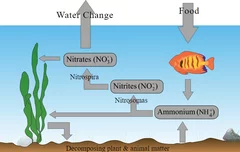
Your Saltwater Reef Tank is a delicate ecosystem with a bacteria population that can support its current inhabitants. Every time you add additional bioload to the tank the bacteria in your system needs time to establish the population needed to support them. These means that your tank goes through another cycle. While not as long as your original, this concept is a must to understand and one of the main reasons things can go downhill quickly if you add too much livestock at once.
#30 Rinse Don’t Wash Before Putting Your Hands in Your Aquarium
You are going to put your hands in the tank, you may think about washing your hands before doing so. Don’t do it. Conventional soaps contain antibacterial chemicals that can harm your tank. Instead, just rinse your hands and arms up to the length you feel that will be touched by your aquarium water. Just rinse them with fresh water and paper towel dry them. Aqua gloves work great as well.
#31 Don’t Chase Aquarium Parameters
We see the list from forums and online sites listing ideal parameters. Yes, you should try to maintain your parameters, but do not obsess over it. Let your tank fall into its groove. Dose the proper amount to get within range, not exact. Inspect your tank to see if everything is healthy and keep up with your maintenance. Everyone’s tank is different – just stay in range and don’t obsess.
#32 Aquarium Test Kits are Not Created Equally

Recall word of wisdom #18 about never compromising on quality. Test Kits are not created equally. Those cheap test kits from Petco are not going to do the job for a saltwater reef tank. Look for high grade saltwater test kits like Salifert, Red Sea, and Hanna.
#33 Supplement, Wait, Then Adjust

When you are initially getting started on a dosing schedule, start slow. It is better to supplement less then more or the recommended amount to start. Work your way up slowly and wait a week before making any adjustments to the schedule. Also, if you do not test for the supplement you are dosing – do not dose it.
#34 Don’t Worry About Trying to Grow Coralline Algae

This is common for newcomers to the hobby. You will get all amped up about growing that purple algae and buy stuff like purple up. Coralline algae is actually quite easy to grow once your tank stabilizes. All it needs is consistent calcium and alkalinity levels – which can be done by consistent water changes. Don’t buy that purple up, just get a good rock from a trusted reef keeper that you know, keep up with your maintenance, and let nature takes its course. After a few months, you’ll be wishing it wouldn’t grow on your aquarium glass.
#35 Dry Rock Rules!
Aquarium Dry Rock Rules! There are so many advantages to using dry rock instead of live rock. You can cut it and shape the rock, you can aquascape it freely, it has zero pests, it saves the wild reef, and it is cheaper. Get a piece of coralline encrusted rock from a friend when you are ready to introduced coralline or purchase a colored dry rock like Caribsea Reef Rock.
Do be careful about starting too sterile as this can result in dinoflagellates. You might want to consider getting some donation live rock from your aquarium club or a friend when you first cycle your tank.
#36 People With Awesome Looking Aquarium Scenes
It is not as simple as getting a bunch of rock and putting it into the tank to create a great looking scape. Several featured tank of the months on forums you see are masterfully aquascaped through a lot of planning. Rockwork is drilled, cut, epoxied, and chiseled. It is usually done with aquarium dry rock and the rockwork is laid out on card board to visualize the aquascape. It is an artwork in itself.
#37 Epoxying Rocks is a Dirty Secret for Bare Bottom Aquarium
You have likely seen several incredible looking bare bottom tanks or even tanks with floating rocks. How do they do it? Well, they epoxy their rocks down during the aquascaping process. The biggest risk in a bare bottom tank is the lack of cushion and rocks can damage the glass if it takes a hard enough tumble. With sand beds we have a little cushion and some reef hobbyists will use eggcrate for an additional safeguard.
With a barebottom tank there is no cushion so the best safeguard is to epoxy down the rocks to ensure they do not slide, slip, or fall.
#38 Beware Buying Livestock Secondhand!
You likely have seen it on craigslist. A killer deal on a fully setup saltwater reef tank with fish and coral included. Buyer beware! First off, moving a fully stock tanked is a ton of work as explained in words of wisdom #13. Second, if you purchase the rock every mistake that previous owner make is going to be inherited with your purchase. Third, you have no idea of the condition of the fish. Yes, they could look healthy but just like at the local fish store you never know.
All these fish should be quarantined before placing in a display tank. All this work and caution alone just makes me avoid them. Have the local fish store take their stuff or have a quarantine tank ready.
#39 Know How to Select a Fish
Knowing how to select a fish goes hand in hand with the next point below. Is the fish compatible with what you already have? How big will it get? Is it reef safe? What does it eat? Once you have that down it’s time to look for physical signs. Is the fish swimming well, does it have puffy lips, any white spots, are the fins intact, does it have any cuts, is the fish’s thick instead of thin.
The last thing to look for does it eat. Never buy a fish from a fish store unless you see it eat at the store. If it is not eating, you are going to have a hard time during the quarantine process keeping them healthy. Online stores can be difficult to purchase from because you never see the fish. You will want to research the store’s reputation from reviews and forums about the quality of the shipped livestock to get the best idea.
#40 Quarantine Your Fish
Not quarantining your fish is asking for trouble. It’s like playing Russian roulette. Anyone who has been in this hobby long enough and has not quarantined fish has likely losses lots of money from preventable diseases that could have been avoided from quarantining.
All it takes is one fish that you add in your tank with ich or marine velvet to infect your entire tank. After the tank has been wiped out, you then you have to wait several weeks for the disease to pass (or worse with marine velvet – several months). There are four tried and methods for quarantining fish that I have detailed out in my How To Quarantine Fish Series:
- Hypersaliny Method
- Copper Method
- Chloroquine Phosphate Method
- The Tank Transfer Method
Save yourself the future pain of loss and invest in a quarantine tank. You can prepare for one now if you have a tank already by placing a sponge in your sump.
#41 Don’t Buy a Fish Your System Cannot Handle
If you have a nano tank, do not go buying a Unicorn Tang. Yes, you may think to yourself now I will just get a bigger tank when they get larger, but the reality is things may change in your life in the next year or so where you may no longer be in the market for that upgrade. If you have a small tank, purchase fish that stay small.
If you have a reef tank, do not purchase butterfly fish. If you have small fish, do not buy a grouper or a lion fish. Do the research for the sake of your fish, wallet, and sanity. Sticking to what you know will work with what you have right now is what you need to be aiming.
#42 Don’t Buy a Saltwater Fish Because It Looks Cool
As a novice, we were all guilty at this at some point. Every now and then the local fish store will stock a rare fish or an exotic fish like a Moorish Idol. It’s hard to resist the urge, but don’t do it. Always research first and make sure you know what the fish needs. Also, don’t buy a fish because you see it as a character in a movie (I’m taking to you Finding Nemo and Finding Dory fans). Know what you are getting into.
#43 Damsels Suck and So Do Large Clownfish
Some of you may have gone to a local fish store already and heard from the rep that damsels are good starter fish because they are hardy. My advice – don’t do it. Most damsels suck. They are highly aggressive and will harass future inhabitants you want to introduce later on. They are also a huge pain to get out of the aquarium once they become problematic.
The same goes with large clownfish like Maroon Clownfish. Maroon clowns not only get large, but they are just as aggressive as damsels. Clownfish are part of the damsel family after all.
If you are thinking about adding a damsel, place check out my blog post about less aggressive damsels and how to add them properly.
#44 Respect the Tang Police

The Tang Police has a polarizing reputation in the saltwater aquarium community. For those of you who do not know, a Tang is one of the larger fish you can add to your aquarium. Most the most part, Tangs are the fish that catch many hobbyist eyes. They are active, herbivores, and wonderful fish to have. Given their size, they really should only be placed in tanks at minimum 4 feet in length for smaller tangs — and 6 feet for many others.
Some hobbyist think the tang police are overreaching, judgmental, and ruthless. Others think they are protecting the well being of these beautiful fish and protecting you from serious mistakes. My take is both sides have a point.
Part of being a successful reef aquarist is having patience and restraint, knowing the limits of your aquarium system and making the best decisions for your long-term success and the well-being of your animals. Make your own decision where you stand, but respect the tang police.
#45 Your Fish Don’t Need That Much Food
Fish are greedy – that’s a simple fact. They will greet every time and give you this sad little look begging you to feed them. Growing up as a kid with a reef tank, this was a daily struggle with my father who couldn’t help himself and feed the fish every time they gave him the little puppy dog eyes.
The fact of the matter is that fish do not need much food. You could only feed what your fish can consume quickly and completely. no extra food should be left at the bottom of the tank. Often for nutrient dense foods like pellets, a pinch is all that is needed. Reef tanks will also produce copepods, amphipods, and algae that many fish will eat. There is plenty of food to go around and overfeeding will just lead to excessive nutrients for algae growth that you do not want.
#46 Don’t Add Fish Too Fast
Recall point #2 about being patient. You can do a ton of damage to your tank by adding fish too fast. Adding too fast will throw off the balance in your bacteria cycle, overload your bioload, cause all sorts of algae blooms from the spike in nutrients, introduce disease due to the added stress, and worse cause a tank crash. Just remember – be patient and go slowly. Do not end up like this lady below:

#47 Don’t Hand Feed Your Fish
If you have fish like a trigger or an eel, just play it safe and don’t hand feed them. As cool as it is to have them eat out of your hand, it’s a very painful lesson when they bite your fingers. Eels have very poor slight and your finger can be mistaken for food. The most aggressive triggers like Clown Triggers should not be trusted for hand feedings. All full grown Clown Trigger jaw’s are powerful enough to bite off your finger. Be smart and use a feeding stick.
#48 Take Extreme Measures When a Fish Gets Sick
I have seen it happen way too many times. A fish gets sick and the aquarium owner tries to treat the display tank or they get one of those new age medications that is invert safe or they buy garlic or a cleaner wrasse. I say no to all of that. If a fish gets sick – EVERYTHING gets pulled out of the tank. Fish all go into quarantine and inverts are pulled into their own tank. All I leave in the tank are the rocks and the coral. I do not mess around with medications – I go straight with what works.
Copper or Chloroquine Phosphate for Ich and Marine Velvet. Treat the fish for at least six weeks. If a fish gets sick again, the clock resets. The time is needed to give the display tank time for the infection to starve itself out and time to remove the sickness from your fish. Any sickness a fish gets is potentially deadly to them. Therefore quick and decisive action is a must!
#49 You Don’t Need as Big as a Clean-up Crew That Stores Claim You Need
Your clean-up crew needs change as your tank gets mature and stocked. Clean up crew sellers will often sell you a full package of cleaners for your tank containing various snails, hermits, etc. My advice to you is do not purchase these packages. You actually do not need as much as they sell. In fact, most of these packages are large because there is a high likelihood that you will lose several of your members.
Most of the time, your tank is not ready for the amount of inverts these packages have and your crew will slowly starve itself out. Instead, just purchase 1 emerald crab and get a few reliable Trochus snails to start out and slowly increase from there. You can learn more about great clean up crew members in my previous post. You can also reduce the need for clean up members by using algae in your sump or a algae turf scrubber.
#50 Dip Your Corals

If you want to prevent coral pests from entering your tank from your coral purchases dipping your corals is a must. There are two ways to dip. You can purchase a specialized dip like Coral RX Coral Dip Pro or you can dip with Bayer Advanced Insect Killer. The Coral RX method is pretty well known and the Bayer method is more advanced.
Either one works great – just make sure you dip. If anything falls out of your corals consider quarantining or returning it. It is even better if you quarantine your corals regardless, but not everyone is willing to do this. You will regret not if you end up with an annoying pest like Asterina Starfish.
#51 Frags Rule!
If you want variety, cheaper corals, and want to experience your reef growing over time, then frags are the way to go. Frags are readily available either through a local store or club frag swaps. It is such a great way to start out and grow in the hobby. You can also make your own Frag Tank and sell or trade corals with others! They are also much easier to handle and place where you want in your aquascaping because of their size. Just remember to leave enough space for everyone to grow.
#52 Don’t Buy a Coral Because It Looks Cool
This is so tempting to do when you are at a local fish store looking at the newest additions or seeing a rare coral in the WYSIWYG section online store. Research first, know what parameters it needs, the lighting, the flow needed, how aggressive it is etc. Also, buy corals in baby steps. If you are not growing basic corals, do not buy the advanced ones. If you only have soft corals don’t go jumping into Acropora SPS corals until you have more experience.
#53 Some Corals Grow Like Weeds and are Invasive
This is a tough lesson some of us have learned when we purchased bullet proof corals. Corals like green star polyps, pulsing xenias, and mushrooms are known for their high reproduction rates. When they are happy, they have the ability to spread like crazy in your tank and can easily take over the entire tank like this picture above of these pulsing Xenias. If you are thinking about getting these types of corals, make sure you know what you are getting yourself into.
#54 Carpet Anemones Suck
Don’t get me wrong carpet anemones are pretty cool and look great in a tank, but they are known for being poor shippers. The ones that do survive shipping can turn out to be deadly additions to your tank. They get very large and have voracious appetites. Many hobbyists who have tried to keep them quickly find out their anemone is a death trap for fish and inverts.
Large fish are not even safe. Once an carpet anemone stings its victim, the tissue damage caused by the sting leaves virtually no chance for the victim to survive. The sting is extremely potent. Check out this video of a carpet anemone eating a blue powder tang as an example:
Carpet Anemones should only be attempted by an advanced aquarist if not just left in the wild.
If you want an anemone, consider a bubble tip anemone.
#55 Always Wear Protection When Coral Fragging
I know many coral fragging tutorial videos do not show safety equipment, but keep in mind that many of these recordings are done by experts or people who have been cutting frags for a long time.The most common hazard is getting coral juices and chucks in your eyes, but a word of caution of you are fragging zoanthids. Zoanthids contain a toxic called palytoxin, which is considered to be one of the most toxic non-protein substances known.
Play it safe and wear razor proof nitrile gloves, eye protection, and a breathing mask. You can call me overly cautious if you like – but I believe in safety first.
Final Thoughts
Wow that was a long post wasn’t it :). Well, I hope you enjoyed reading this blog post and took away some words of wisdom. As always, please share and subscribe to our newsletter to gave more great articles like this and specials from our store. If you have any tips you would like to share, please leave us a comment below. Thanks for reading and see you next time!
- About the Author
- Latest Posts
I’m thrilled that you found Aquarium Store Depot! Here you’ll find information on fish, aquariums, and all things aquatics related. I’m a hobbyist (being doing this since I was 11) and here to help other hobbyists thrive with their aquariums! I adhere to a high quality Editorial Process and Review products with real life field usage and practical analysis.

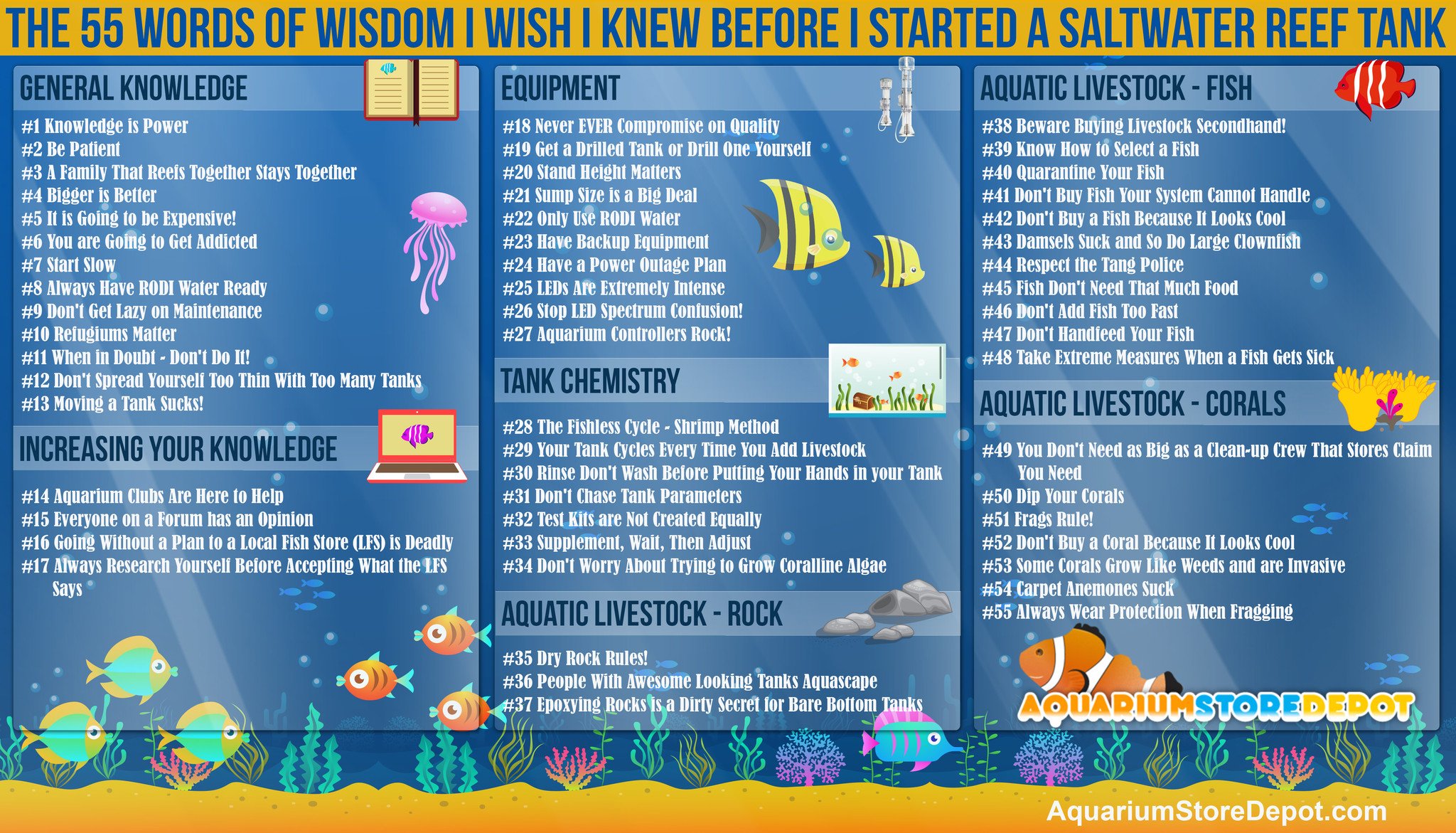

















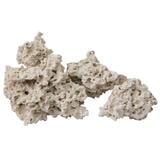



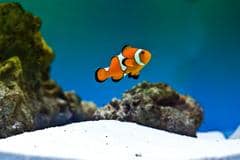
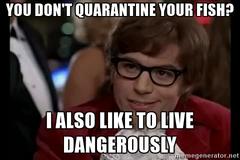















I loved your post. Are you local to the area of Minnesota? I would love to see your tank and I would like to have you look at mine. I live in a suburb of Minneapolis Minnesota. Lee
Hi Lee. I don’t live in Minnesota. I live in Texas. We can touch base via email info@aquariumstoredepot.com.
Hi Dennis,
If it is a brown dusty like looking algae that is called diatoms. That is put of the cycle process on new saltwater tanks. It should go away over time. You will go through several algae cycles until you level off to green and coralline algae. Just keep an eye on it and your nutrient levels.
Loved the article being new to the salt water world. I have a lot of brown what looks like alge on the bottom of the tank. I have seen a few videos saying this is normal and not harmful and part of the process just wonder on people’s thoughts on this
This was so very informative and timely. I’m an experienced freshwater hobbyist but just ordered my first saltwater tank. Before having even read this blog, I made the conscious decision to go slow and not act impulsively with equipment/livestock purchases. I have been trying to watch as many videos and read as many articles on saltwater tanks as I can while waiting on my 60 gal tank to arrive. Unfortunately, its so hard to know who is an “expert” and who is just tossing out misinformation. And apparently there are so many different methods and theories to water maintenance (e.g. Triton, Zeovit, weekly water changes, 2-part dosing, etc.). It can all be so overwhelming. But I think your blog has helped settle my nerves and to become focused again, lol. Thank you!
Very informative post, it’s book marked now. It’s 3:00 a.m….wish I would have found it earlier but its so PACKED with such GREAT advice I couldn’t stop in the middle. Thanks again!
Great tutorial. I’m an advanced reefer, but I learned many of these lessons the hard way. I wish I had read such article when I was a beginner.
Hi Evelyn,
I would wait it. Your tank is very new and you are going through your first algae outbreak. Keep up with the maintenance and make sure you have an RODI system so you don’t add nutrients to that algae. It sounds like you are on the right track :).
Great reading, as we are ,4 weeks into our new tank, just getting brown algae , omg . All the water tests are fine , got 2 small cardinals, ( couldn’t help myself) but not sure what to do now, done a water change, tests all ok, so do I just wait it out, THANKYOU
Good article and a lot of knowledge for a newbie. Thanks.
Haha, I love #42. Don’t buy a fish cause it looks cool. I’ve heard lots of talk about being careful when buying the Dori fish.
Great list. Thanks for the share.